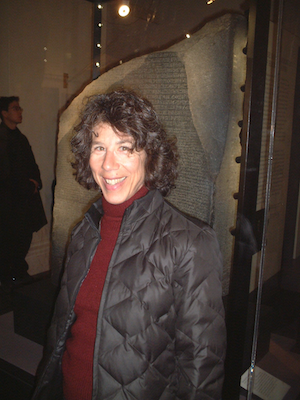VIS KEYNOTE INVITED TALK

Alberto Cairo
Journalist, designer, and Professor of Visualization, Infographics and Data Journalism
Shool of Communication, University of Miami
Title
The Island of Knowledge and the Shorelines of Wonder.
Visualization and Infographics for an Enlightned World
Abstract
To say that giving data a visual shape helps us humans comprehend the increasing complexity of the world isn't particularly surprising nowadays. Or is it? Are we really working to transform visualization into a tool that all citizens can use? Are we building bridges to connect the multitude of disciplines that deal with visualization and information graphics today, in many cases without being aware of what goes on beyond their boundaries? Perhaps we aren't. It may be time to face that challenge head-on.
Speaker Bio
Alberto Cairo is a journalist, designer, and professor of visualization, infographics, and data journalism at the School of Communication of the University of Miami. He is also the head of the visualization program at UM's Center for Computational Science. He has been director of interactive graphics at El Mundo newspaper (Spain, 2000-2005), a professor at the University of North Carolina-Chapel Hill (2005-2009), and director of multimedia and infographics at Editora Globo (Brazil, 2009-2012).
Cairo is the author of the book ‘The Functional Art: An Introduction to Information Graphics and Communication’. He has taught courses and workshops in two dozen countries, and run four editions of a Massive Open Online Course (MOOC) about visualization for communication that has attracted 14,000 people from more than 100 countries. He tweets as @albertocairo and his website is www.thefunctionalart.com.
VIS CAPSTONE INVITED TALK

Barbara Tversky
Professor of Psychology Emerita at Stanford University
Professor of Psychology at Columbia Teachers College
Title
Understanding and Conveying Events
Abstract
The world presents us with an overwhelming continuous multi-media flow of information to all the senses. From that we carve discrete chunks, events. Events can be analyzed as kinds and as parts. Our research on segmenting everyday events like making a bed shows a confluence of top-down (goal-completion) and bottom-up (local maxima of information change) features at event segment boundaries that allow inferences from one to the other. The flip side of understanding events is communicating them, using a range of linguistic diagrammatic, and pictorial devices. Analysis of research and examples from history, diagrams, and comics will illustrate ways to convey events visually.
Speaker Bio
Barbara Tversky is a cognitive scientist who has worked on memory, categorization, spatial language and thinking, event perception and cognition, diagrammatic reasoning, creativity, and gesture. She has enjoyed collaborating with computer scientists, linguists, philosophers, engineers, educators, biologists, chemists, geographers, artists, and designers on a range of projects. She is Professor of Psychology Emerita at Stanford University and Professor of Psychology at Columbia Teachers College. She is a member of the American Academy of Arts and Sciences and a Fellow of the Cognitive Science Society, the Society for Experimental Psychology, the Psychonomic Society, and the Association for Psychological Science.
LDAV KEYNOTE INVITED TALK

Anders Ynnerman
Department of Science and Technology
Linköping University
Title
Inside Information - From Martian Meteorites to Mummies
Abstract
In the last decades imaging modalities have advanced beyond recognition and data of rapidly increasing size and quality can be captured with high speed. This talk will show how data visualization can be used to provide public visitor venues, such as museums, science centers and zoos with unique interactive learning experiences. By combining data visualization techniques with technologies such as interactive multi-touch tables and intuitive user interfaces, visitors can conduct guided browsing of large volumetric image data. The visitors then themselves become the explorers of the normally invisible interior of unique artifacts and subjects. The talk will take its starting point in the current state-of-the-art in CT and MRI scanning technology. It will then discuss the latest high-quality interactive volume rendering and multi-resolution techniques for large scale data and how they are tailored for use in public spaces. Examples will then be shown of how the inside workings of the human body, exotic animals, natural history subjects, such as the martian meteorite, or even mummies can be explored interactively. The recent mummy installation at the British Museum will be shown and discussed from both a curator and visitor perspective and results from a 3 month trial period in the galleries will be presented.
Speaker Bio
Professor Anders Ynnerman received a Ph.D. in physics from Gothenburg University. During the early 90s he was at Oxford University, UK, and Vanderbilt University, USA. From 1997 to 2002 he directed the Swedish National Supercomputer Centre and from 2002 to 2006 he directed the Swedish National Infrastructure for Computing (SNIC). Since 1999 he has held a chair in scientific visualization at Linköping University and is the director of the Norrköping Visualization Center – C.
Ynnerman is a member of the Swedish Royal Academy of Engineering Sciences and a board member of the Foundation for Strategic Research. In 2007 Ynnerman was awarded the Akzo Nobel Science award and the Golden Mouse award for Swedish IT-person of the year. In 2009 he received the Athena Award for best medical clinical research in Sweden and in 2010 he received the Swedish Knowledge Award for dissemination of scientific knowledge to the public. In 2011 he received the IVA gold medal from the King of Sweden. He is currently vice chair of the Eurographics Association and is papers co-chair of IEEE SciVis 2014.


